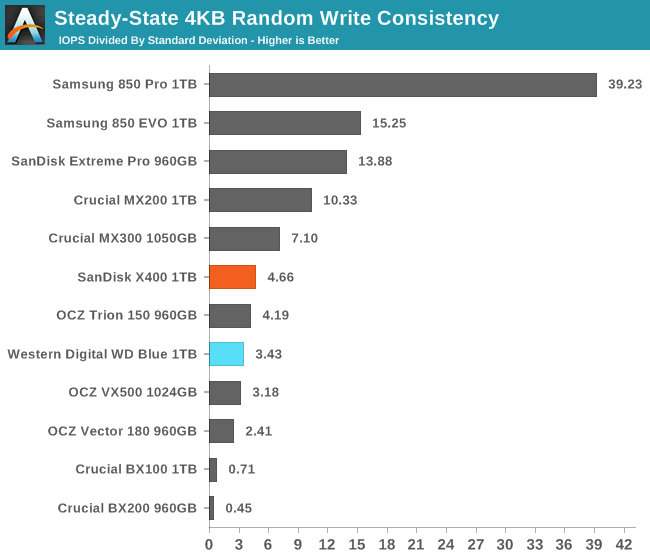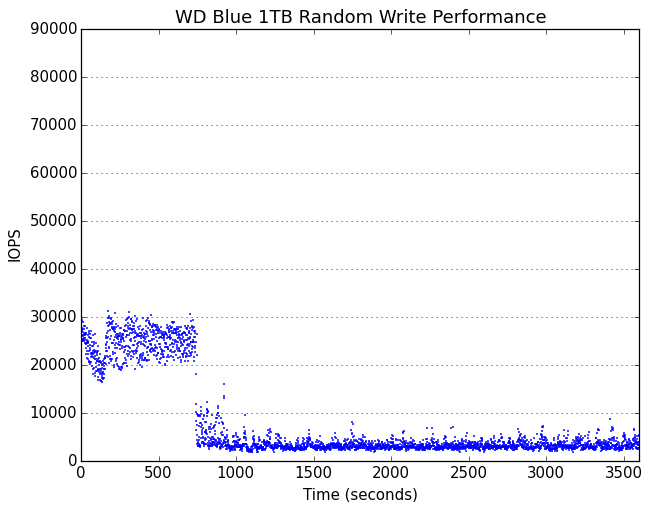The Western Digital Blue (1TB) SSD Review: WD Returns to SSDs
by Billy Tallis on October 11, 2016 8:00 AM EST- Posted in
- SSDs
- Storage
- Western Digital
- SanDisk
Performance Consistency
Our performance consistency test explores the extent to which a drive can reliably sustain performance during a long-duration random write test. Specifications for consumer drives typically list peak performance numbers only attainable in ideal conditions. The performance in a worst-case scenario can be drastically different as over the course of a long test drives can run out of spare area, have to start performing garbage collection, and sometimes even reach power or thermal limits.
In addition to an overall decline in performance, a long test can show patterns in how performance varies on shorter timescales. Some drives will exhibit very little variance in performance from second to second, while others will show massive drops in performance during each garbage collection cycle but otherwise maintain good performance, and others show constantly wide variance. If a drive periodically slows to hard drive levels of performance, it may feel slow to use even if its overall average performance is very high.
To maximally stress the drive's controller and force it to perform garbage collection and wear leveling, this test conducts 4kB random writes with a queue depth of 32. The drive is filled before the start of the test, and the test duration is one hour. Any spare area will be exhausted early in the test and by the end of the hour even the largest drives with the most overprovisioning will have reached a steady state. We use the last 400 seconds of the test to score the drive both on steady-state average writes per second and on its performance divided by the standard deviation.

With a slight increase in out of the box overprovisioning, it is unsurprising to see the WD Blue improve on the SanDisk X400's steady-state random write performance. The WD Blue overtakes the OCZ Trion 150 as the fastest planar TLC NAND SSD, but doesn't catch up to the MLC or 3D TLC drives.

The WD Blue has slightly worse performance consistency than the X400, but not low enough to be cause for concern.
 |
|||||||||
| Default | |||||||||
| 25% Over-Provisioning | |||||||||
Before reaching steady state, the WD Blue hovers between 20k and 30k IOPS, a significant improvement over the X400. Several other competitors have higher peak performance, but are either less consistent during the early phase of the test or don't last as long before dropping to steady state.
 |
|||||||||
| Default | |||||||||
| 25% Over-Provisioning | |||||||||
Upon reaching steady state, the WD Blue varies from roughly 2500 IOPS to 5000 IOPS, with short bursts of slightly higher performance. With extra overprovisioning the base performance of the WD Blue doesn't change but the upper limit of its normal band of performance increases to around 10k IOPS and the peaks reach 25k.










75 Comments
View All Comments
TheinsanegamerN - Tuesday, October 11, 2016 - link
it's an interesting drive, but why buy these when the likes of the mushkin reactor are $60 cheaper for the 1TB varient? sata III drives have peaked performance wise.OTOH, cant wait to see what the WD black SSDs look like. 4TB? M.2 PCIE?
dave_the_nerd - Tuesday, October 11, 2016 - link
The Reactor 1TB was a clone of the BX100... which outperformed the WD Blue in a lot of tests here. Getting harder to find them though.Hopefully the street price of this will be more in-line with the rest of the market, price/performance wise.
TheinsanegamerN - Tuesday, October 11, 2016 - link
the only thing this WD drive does better is write endurance. 400TB, or even 320TB for the sandisk version, is a heck of a lot better then the 144TB of the 1TB reactor drive.ammacdo - Tuesday, October 11, 2016 - link
The thing I like most about this review is seeing how well my BX100 still holds up, and I paid the same MSRP this one is going for over a year ago.paulgj - Monday, October 31, 2016 - link
I agree, I bought half a dozen BX100's when they went on sale. Excellent MLC SSDs.Bullwinkle J Moose - Tuesday, October 11, 2016 - link
It depends on the consistency of performance and not the peakThe concern I have is Sandisk consistency of performance which cannot be checked using a single test drive
I have 3 of the Sandisk Extreme Pro thumbdrives that are Windows to Go compatible as they are "Fixed Disks"
One of them is completely unusable after a week, one is so-so and one is very good (performance wise)
The only thing that will return the speed to "Like-New" condition is using Killdisk over the entire drive
The CrapCleaner Drive wipe utility does not return full performance, and the new Defraggler SSD Optimizer does not return full performance
I have not found any method other than Killdisk to temporarily regain full disk performance
Of course, not having Trim or Garbage collection exacerbates the problem which then accelerates the thermal throttling issue
Mushkin also has a bad rep for thermal issues on their Win2Go compatible thumbdrives
The new Corsair GTX beats them all hands down for Windows to go and since my test machine is an older Sandy Bridge for XP compatability, the corsair is actually faster on the USB3 port than my Samsung 850 Pro is on the SATA2 ports
I hope Anandtech can address consistency between identical drives at some point
Bullwinkle J Moose - Tuesday, October 11, 2016 - link
Corsair GTX Thumb drives seem VERY Consistent between drives as wellWwhat - Sunday, October 30, 2016 - link
You seem to be a pretty unique case and not an average user in any way.But it's still an interesting comment I feel. Or I should say 'because of that' rather than 'still'.
Bulat Ziganshin - Saturday, October 15, 2016 - link
they can't build Black from air. sandisk best ssd is extreme pro, so Black will be updated version of itnathanddrews - Tuesday, October 11, 2016 - link
Does this WD SSD come with software to clone/shrink your existing drive to the new SSD? I have an older SiliconEdge Blue 64GB SSD (still working well) and WD offers a utility on their website to do just that, but only if there is a WD drive attached to the machine. I assume this utility would work with this SSD? Not sure if you image your test drives using different tools or what.Samsung has another great utility that comes with a slick SATA-to-USB 3.0 dongle (free in the box) that will clone/shrink any drive to a target Samsung SSD. They go above and beyond the capabilities of Windows volume shrink by a lot.